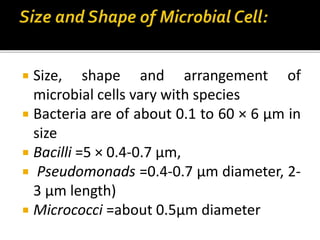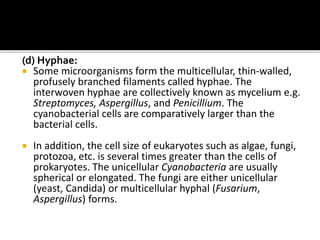Morphological diversity of microbes
- 1. Prepared by : Dr Misbah Ajaz Dept of Microbiology,BGSBU,Rajouri
- 2. ’éĪ Size, shape and arrangement of microbial cells vary with species ’éĪ Bacteria are of about 0.1 to 60 ├Ś 6 ┬Ąm in size ’éĪ Bacilli =5 ├Ś 0.4-0.7 ┬Ąm, ’éĪ Pseudomonads =0.4-0.7 ┬Ąm diameter, 2- 3 ┬Ąm length) ’éĪ Micrococci =about 0.5┬Ąm diameter
- 4. ’éĪ Generally, the bacterial cells are spherical (coccus, plural cocci which mean berries) ’éĪ Elongated rods (Bacillus, plural bacilli), helical rods (Spirillum, plural spirilli) ’éĪ Pear-shaped (Pasteurid), lobed spheres (Sulf ’éĪ olobus), rods with squared ends (Bacillus anthracis) ’éĪ Rods with helically sculptured surface (Seliberid) and of changing shape (pleomorphic), etc. ’éĪ Unicellular cyanobacterial cells are usually spherical (Chroococcus, Scenedesmus, Anacystis) ’éĪ Some are elongated and multicellular.
- 5. ’éĪ Arrangement of cells is more complex in cocci than bacilli. ’éĪ The arrangement of cells depends upon adherence of cells together after the cell division
- 6. COCCUS FORMS: ’éĪ Diplococcus ’éĪ ’éĪ Streptococcus ’éĪ Tetracocci ’éĪ Straphylococci ’éĪ Sarcinae: BACILLUS FORMS ’éĪ Mono-bacillus ’éĪ Diplobacillus ’éĪ Streptobacillus ’éĪ Coccobacillus
- 7. FORMS OF SPIRILLI ’éĪ Vibrioid ’éĪ Helical OTHER FORMS ’éĪ Pleomorphic ’éĪ Trichomes ’éĪ Palisade ’éĪ Hyphae
- 8. There are several groups of cocci based on the number and arrangement of cells. (a) Diplococcus: ’éĪ Cells divide in one plane and get attached permanently in pairs. (b) Streptococcus: ’éĪ Cells divide in one plane and remain attached to form a linear chain of cells. i) Coccus Form
- 9. (c)Tetracocci: ’éĪ Cells divide in two planes and form groups of four cells. (d) Straphylococci: ’éĪ Cells divide in three planes in an irregular pattern producing bunches of cocci. (e) Sarcinae: ’éĪ Cells divide in three planes in regular pattern producing bunches of cocci.
- 10. There are a few groups of bacilli unlike cocci as the former divide across their short aries. (a) Mono-bacillus: ’éĪ The single elongated cells freely present in nature are mono- bacillus. (b) Diplobacillus: ’éĪ After division the cells remain adhered and appear in paired form. (c) Streptobacillus: ’éĪ After division the cells remain attached in chains appearing like straws. (d) Coccobacillus: ’éĪ The oval cells looking like cocci are called coccobacilli ’éĪ There is two meaning of bacillus, one is the form and the second is the genus. For example the bacterium Bacillus anthracis causes anthrax disease.
- 11. (a) Vibrioid: ’éĪ Bacterial cells having less than one complete twist form vibrioid shape e.g. Vibrio cholerae. (b) Helical: ’éĪ Cells that have more than one twist form a distinct helical shape e.g. Spirillum (with flagella).
- 12. (a) Pleomorphic: ’éĪ Of changing forms e.g. Rhizobium, Mycoplasma, etc. (b) Trichomes: ’éĪ Cells divide in one plane forming a chain which has much larger area of contact between the adjacent cells e.g. Baggiatoa, Saprospria. (c) Palisade: ’éĪ The cells are arranged laterally (side by side) to form a match sticks like structure and at angles to one another e.g. Corynebacterimn diphtheriae.
- 13. (d) Hyphae: ’éĪ Some microorganisms form the multicellular, thin-walled, profusely branched filaments called hyphae. The interwoven hyphae are collectively known as mycelium e.g. Streptomyces, Aspergillus, and Penicillium. The cyanobacterial cells are comparatively larger than the bacterial cells. ’éĪ In addition, the cell size of eukaryotes such as algae, fungi, protozoa, etc. is several times greater than the cells of prokaryotes. The unicellular Cyanobacteria are usually spherical or elongated. The fungi are either unicellular (yeast, Candida) or multicellular hyphal (Fusarium, Aspergillus) forms.
- 17. Thank you
















